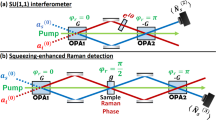Abstract
THE techniques of coherent Raman spectroscopy are revolutionising the applications and scope of Raman spectroscopy. Particularly important aspects are: very high resolution spectroscopy (the Doppler width being proportional to the Raman shift of the band under study); nanosecond (and sub-nanosecond) spectroscopy, where the resolution obtained may be limited by the Fourier transform of the experimental time scale; discrimination against luminescence from the sample (whether laser induced or not). We discuss here coherent anti-Stokes Raman spectroscopy (CARS) at low frequency shifts.
Similar content being viewed by others
References
Nitsch, W. & Kiefer, W. Opt. Commun. 23, 240 (1978).
Nibler, J. W., McDonald, J. R. & Harvey, A. B. Opt. Commun. 18, 371 (1976).
Beattie, I. R. & Black, J. D. Vibrational Spectroscopy—Modern Trends (eds Barnes, A. J. & Orville-Thomas, W. J.) 21–31 (Elsevier, Amsterdam, 1977).
Beattie, I. R., Greenhalgh, D. A. & Yuratich, M. (in preparation).
Eckbreth, A. C. Appl. phys. Lett. 32, 421 (1978).
Author information
Authors and Affiliations
Rights and permissions
About this article
Cite this article
BEATTIE, I., GILSON, T. & GREENHALGH, D. Low frequency coherent anti-Stokes Raman spectroscopy of air. Nature 276, 378–379 (1978). https://doi.org/10.1038/276378a0
Received:
Accepted:
Issue Date:
DOI: https://doi.org/10.1038/276378a0
- Springer Nature Limited
This article is cited by
-
Oxygen concentration and temperature measurements in N2?O2 mixtures using rotational coherent anti-Stokes Raman spectroscopy
Applied Physics B Laser and Optics (1996)
-
Multiplex rotational CARS of N2, O2, and CO with excimer pumped dye lasers: Species identification and thermometry in the intermediate temperature range with high temporal and spatial resolution
Applied Physics B Photophysics and Laser Chemistry (1986)
-
Experimental study of vibrational and pure rotational coherent anti-stokes Raman scattering (CARS) in molecular hydrogen
Applied Physics B Photophysics and Laser Chemistry (1986)





